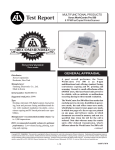Download Dell PowerEdge 500SC User's Manual
Transcript
Dell™ PowerEdge™ 500SC Systems User's Guide System Overview System Orientation Front-Panel Indicators and Features Back-Panel Features System Features Supported Operating Systems Power Protection Devices Other Documents You May Need Getting Help Using the Dell OpenManage™ Server Assistant CD Starting the Dell OpenManage Server Assistant CD Navigating the CD Setting Up Your System Utility Partition Asset Tag Utility Using the System Setup Program Entering the System Setup Program System Setup Options Using the System Password Feature Using the Setup Password Feature Disabling a Forgotten Password Technical Specifications I/O Ports and Connectors I/O Ports and Connectors Serial and Parallel Connectors Keyboard and Mouse Connectors Video Connector USB Connectors Integrated Network Interface Controller Connector Glossary Figures Tables Notes, Notices, Cautions, and Warnings NOTE: A NOTE indicates important information that helps you make better use of your computer. NOTICE: A NOTICE indicates either potential damage to hardware or loss of data and tells you how to avoid the problem. CAUTION: A CAUTION indicates a potentially hazardous situation which, if not avoided, may result in minor or moderate injury. WARNING: A WARNING indicates a potentially hazardous situation which, if not avoided, may result in severe injury. Model MMS Information in this document is subject to change without notice. © 2001 Dell Computer Corporation. All rights reserved. Reproduction in any manner whatsoever without the written permission of Dell Computer Corporation is strictly forbidden. Trademarks used in this text: Dell, PowerEdge, the DELL logo, and Dell OpenManage are trademarks of Dell Computer Corporation; Intel and Pentium are registered trademarks and Celeron is a trademark of Intel Corporation; Microsoft, MS-DOS, Windows, and Windows NT are registered trademarks of Microsoft Corporation; Novell and NetWare are registered trademarks of Novell, Inc. Other trademarks and trade names may be used in this document to refer to either the entities claiming the marks and names or their products. Dell Computer Corporation disclaims any proprietary interest in trademarks and trade names other than its own. May 2001 Back to Contents Page Technical Specifications Dell™ PowerEdge™ 500SC Systems User's Guide Table A-1. Technical Specifications Microprocessor Microprocessor type Intel® Pentium® III microprocessor with a minimum of 1 GHz, an external bus speed of 133 MHz, and a 256 KB level 2 cache OR Intel Celeron™ microprocessor at 800 MHz with an external bus speed of 100 MHz and a 128 KB level 2 cache Front-side bus speed Pentium III: 133 MHz Celeron: 100 MHz Internal cache Pentium III: 256 KB Level 2 cache Celeron: 128 KB Level 2 cache Expansion Bus Bus type PCI Expansion slots Two 64-bit, 33/66-MHz slots Three 32-bit, 33-MHz slots Memory Architecture 72-bit ECC PC-133 SDRAM Memory module sockets four Memory module capacities 64, 128, 256, or 512 MB Minimum RAM 64 MB Maximum RAM 2 GB Diskette drive 3.5-inch, 1.44-MB diskette drive Tape drive optional internal tape drive IDE devices three 1-inch, internal, IDE hard drive bays CD drive one IDE CD drive Drives Ports and Connectors Externally accessible: Serial (DTE) one 9-pin connector; 16550-compatible Parallel one 25-pin connector (bidirectional) Video one 15-pin connector PS/2-style keyboard 6-pin mini-DIN connector PS/2-compatible mouse 6-pin mini-DIN connector USB two USB-compliant 4-pin connectors NIC RJ45 connector for integrated NIC Video Video type ATI Rage XL video controller; VGA connector Video memory 4 MB DC power supply: Power Wattage one 250-W or 330-W power supply Voltage 90–240 V, 47/63 Hz or 90–265 V, 47/63 Hz System battery CR2032 3.0-V lithium coin cell Physical Height 43.7 cm (17.2 inches) Width 20.3 cm (8 inches) Depth 44.5 cm (17.5 inches) Weight 15.0 kg (33 lb), maximum configuration Temperature: Environmental Operating 10° to 35° C (50° to 95° F) Storage –40° to 65° C (–40° to 149° F) Relative humidity: 20% to 80 noncondensing Maximum vibration: Operating 0.25 G at 3 to 200 Hz at 1/2 octave/min Storage 0.5 G at 3 to 200 Hz at 1/2 octave/min Maximum shock: Operating left side and bottom half-sine pulse with a change in velocity of 50.8 cm/sec (20 inches/sec) Storage 23-G faired-square wave with a velocity change of 508.0 cm/sec (200 inches/sec) Altitude: Operating –15.2 to 3048 m (–50 to 10,000 ft)1 Storage –15.2 to 10,600 m (–50 to 35,000 ft) 1 At 35°C (95°F), the maximum operating altitude is 914 m (3000 ft). NOTE: For the full name of an abbreviation or acronym used in this table, see the Glossary. Back to Contents Page Back to Contents Page I/O Ports and Connectors Dell™ PowerEdge™ 500SC Systems User's Guide I/O Ports and Connectors Serial and Parallel Connectors Keyboard and Mouse Connectors Video Connector USB Connectors Integrated Network Interface Controller Connector I/O Ports and Connectors The I/O ports and connectors on the back panel of the system are the gateways through which the system communicates with external devices, such as a keyboard, mouse, printer, and monitor. Figure B-1 identifies the I/O ports and connectors for your system. Figure B-1. I/O Ports and Connectors Serial and Parallel Connectors The integrated serial connector uses a 9-pin D-subminiature connector on the back panel. This port supports devices such as external modems, printers, plotters, and mice that require serial data transmission (the transmission of data one bit at a time over one line). Most software uses the term COM (for communications) plus a number to designate a serial connector (for example, COM1). The default designations of your system's integrated serial connector is COM1. The integrated parallel connector uses a 25-pin D-subminiature connector on the system's back panel. This I/O port sends data in parallel format (where eight data bits, or one byte, are sent simultaneously over eight separate lines in a single cable). The parallel connector is used primarily for printers. Most software uses the term LPT (for line printer) plus a number to designate a parallel connector (for example, LPT1). The default designation of the system's integrated parallel connector is LPT1. Port designations are used, for example, in software installation procedures that include a step in which you identify the port to which a printer is attached, thus telling the software where to send its output. (An incorrect designation prevents the printer from printing or causes scrambled print.) Adding an Expansion Card Containing Serial or Parallel Connectors The system has an autoconfiguration capability for the serial connectors. This feature lets you add an expansion card containing a serial connector that has the same designation as one of the integrated ports, without having to reconfigure the card. When the system detects the duplicate serial connector on the expansion card, it remaps (reassigns) the integrated port to the next available port designation. Both the new and the remapped COM ports share the same interrupt request (IRQ) setting, as follows: COM1, COM3: IRQ4 (shared setting) COM2, COM4: IRQ3 (shared setting) These COM ports have the following I/O address settings: COM1: COM2: COM3: COM4: 3F8h 2F8h 3E8h 2E8h For example, if you add an internal modem card with a port configured as COM1, the system then sees logical COM1 as the address on the modem card. It automatically remaps the integrated serial connector that was designated as COM1 to COM3, which shares the COM1 IRQ setting. (Note that when you have two COM ports sharing an IRQ setting, you can use either port as necessary but you may not be able to use them both at the same time.) If you install one or more expansion cards with serial connectors designated as COM1 and COM3, the corresponding integrated serial connector is disabled. Before adding a card that remaps the COM ports, check the documentation that accompanied your software to make sure that the software can be mapped to the new COM port designation. To avoid autoconfiguration, you may be able to reset jumpers on the expansion card so that the card's port designation changes to the next available COM number, leaving the designation for the integrated port as is. Alternatively, you can disable the integrated ports through the System Setup program. The documentation for your expansion card should provide the card's default I/O address and allowable IRQ settings. It should also provide instructions for readdressing the port and changing the IRQ setting, if necessary. If you add an expansion card containing, for example a parallel connector configured as LPT1 (IRQ7, I/O address 378h), you must go into the System Setup program to remap the integrated parallel connector. For general information on how your operating system handles serial and parallel connectors, and for more detailed command procedures, see your operating system documentation. Serial Connectors If you reconfigure your hardware, you may need pin number and signal information for the serial connectors. Figure B-2 illustrates the pin numbers for the serial connectors and Table B-1 defines the pin assignments and interface signals for the serial connector. Figure B-2. Pin Numbers for the Serial Connectors Table B-1. Pin Numbers for the Serial Connectors Pin Signal I/O Definition 1 DCD I Data carrier detect 2 SIN I Serial input 3 SOUT O Serial output 4 DTR O Data terminal ready 5 GND N/A Signal ground 6 DSR I Data set ready 7 RTS O Request to send 8 CTS I Clear to send 9 RI I Ring indicator N/A Chassis ground Shell N/A Parallel Connector If you reconfigure your hardware, you may need pin number and signal information for the parallel connector. Figure B-3 illustrates the pin numbers for the parallel connector and Table B-2 defines the pin assignments and interface signals for the parallel connector. Figure B-3. Pin Numbers for the Parallel Connector Table B-2. Parallel Connector Pin Assignments Pin Signal I/O Definition 1 STB# I/O Strobe 2 PD0 I/O Printer data bit 0 3 PD1 I/O Printer data bit 1 4 PD2 I/O Printer data bit 2 5 PD3 I/O Printer data bit 3 6 PD4 I/O Printer data bit 4 7 PD5 I/O Printer data bit 5 8 PD6 I/O Printer data bit 6 9 PD7 I/O Printer data bit 7 10 ACK# I Acknowledge 11 BUSY I Busy 12 PE I Paper end 13 SLCT I Select 14 AFD# O Automatic feed 15 ERR# I Error 16 INIT# O Initialize printer 17 SLIN# O Select in N/A Signal ground 18–25 GND Keyboard and Mouse Connectors The system uses a Personal System/2 (PS/2)-style keyboard and supports a PS/2-compatible mouse. Cables from both devices attach to 6-pin, miniature Deutsche Industrie Norm (DIN) connectors on the back panel of your system. Mouse driver software can give the mouse priority with the microprocessor by issuing IRQ12 whenever a new mouse movement is detected. The driver software also passes along the mouse data to the application program that is in control. Keyboard Connector If you reconfigure your hardware, you may need pin number and signal information for the keyboard connector. Figure B-4 illustrates the pin numbers for the keyboard connector and Table B-3 defines the pin assignments and interface signals for the keyboard connector. Figure B-4. Pin Numbers for the Keyboard Connector Table B-3. Keyboard Connector Pin Assignments Pin Signal 1 KBDATA I/O I/O Definition Keyboard data 2 NC N/A No connection 3 GND N/A Signal ground 4 FVcc N/A Fused supply voltage 5 KBCLK I/O Keyboard clock 6 NC N/A No connection N/A Chassis ground Shell N/A Mouse Connector If you reconfigure your hardware, you may need pin number and signal information for the mouse connector. Figure B-5 illustrates the pin numbers for the mouse connector, and Table B-4 defines the pin assignments and interface signals for the mouse connector. Figure B-5. Pin Numbers for the Mouse Connector Table B-4. Mouse Connector Pin Assignments Pin Signal 1 MFDATA I/O Mouse data 2 NC N/A No connection 3 GND N/A Signal ground 4 FVcc N/A Fused supply voltage 5 MFCLK I/O Mouse clock 6 NC N/A No connection N/A Chassis ground Shell N/A I/O Definition Video Connector The system uses a 15-pin high-density D-subminiature connector on the back panel for attaching a video graphics array (VGA)-compatible monitor to your system. The video circuitry on the system board synchronizes the signals that drive the red, green, and blue electron guns in the monitor. NOTE: Installing a video card automatically disables the system's integrated video subsystem. If you reconfigure your hardware, you may need pin number and signal information for the video connector. Figure B-6 illustrates the pin numbers for the video connector, and Table B-5 defines the pin assignments and interface signals for the video connector. Figure B-6. Pin Numbers for the Video Connector Table B-5. Video Connector Pin Assignments Pin Signal I/O Definition 1 RED O Red video 2 GREEN O Green video 3 BLUE O Blue video 4 N/A No connection 5–8, 10 GND NC N/A Signal ground 9 VCC N/A Vcc 11 NC N/A No connection 12 DDC data out O Monitor detect data 13 HSYNC O Horizontal synchronization 14 VSYNC O Vertical synchronization 15 DDC clock out O Monitor detect clock Shell N/A Chassis ground N/A USB Connectors Your system contains two Universal Serial Bus (USB) connectors for attaching USB-compliant devices. USB devices are typically peripherals such as mice, printers, keyboards, and system speakers. NOTICE: Do not attach a USB device or a combination of USB devices that draw a maximum current over 500 milliamperes (mA) per channel or +5 volts (V). Attaching devices that exceed this threshold may cause the USB ports to shut down. See the documentation that accompanied the USB devices for their maximum current ratings. If you reconfigure your hardware, you may need pin number and signal information for the USB connectors. Figure B-7 illustrates the USB connector and Table B-6 defines the pin assignments and interface signals for the USB connector. Figure B-7. Pin Numbers for the USB Connector Table B-6. USB Connector Pin Assignments Pin Signal I/O Definition 1 Vcc N/A Supply voltage 2 DATA I Data in 3 +DATA O Data out 4 GND Signal ground N/A Integrated Network Interface Controller Connector Your system has an integrated 10/100–megabit-per-second (Mbps) network interface controller (NIC). The NIC provides all the functions of a separate network expansion card and supports both the 10BASE-T and 100BASE-TX Ethernet standards. Network Cable Requirements Your system's RJ45 NIC connector is designed for attaching an unshielded twisted pair (UTP) Ethernet cable equipped with standard RJ45-compatible plugs. Press one end of the UTP cable into the NIC connector until the plug snaps securely into place. Connect the other end of the cable to an RJ45 jack wall plate or to an RJ45 port on a UTP concentrator or hub, depending on your network configuration. Observe the following cabling restrictions for 10BASE-T and 100BASETX networks. NOTICE: To avoid line interference, voice and data lines must be in separate sheaths. l For 10BASE-T networks, use Category 3 or greater wiring and connectors. l For 100BASE-TX networks, use Category 5 or greater wiring and connectors. l The maximum cable run length (from a workstation to a concentrator) is 328 feet (ft) (100 meters [m]). l For 10BASE-T networks, the maximum number of daisy-chained concentrators on one network segment is four. Figure B-8. NIC Connector Back to Contents Page Back to Contents Page Tables Dell™ PowerEdge™ 500SC Systems User's Guide Table Table Table Table Table Table Table Table Table Table 2-1. 2-2. 3-1. A-1. B-1. B-2. B-3. B-4. B-5. B-6. Utility Partition Main Menu Options Asset Tag Command-Line Options System Setup Navigation Keys Technical Specifications Pin Numbers for the Serial Connectors Parallel Connector Pin Assignments Keyboard Connector Pin Assignments Mouse Connector Pin Assignments Video Connector Pin Assignments USB Connector Pin Assignments Back to Contents Page Back to Contents Page Figures Dell™ PowerEdge™ 500SC Systems User's Guide Figure Figure Figure Figure Figure Figure Figure Figure Figure Figure Figure Figure 1-1. 1-2. 1-3. 3-1. B-1. B-2. B-3. B-4. B-5. B-6. B-7. B-8. System Orientation Front-Panel Features Back-Panel Features Main System Setup Screen I/O Ports and Connectors Pin Numbers for the Serial Connectors Pin Numbers for the Parallel Connector Pin Numbers for the Keyboard Connector Pin Numbers for the Mouse Connector Pin Numbers for the Video Connector Pin Numbers for the USB Connector NIC Connector Back to Contents Page Back to Contents Page System Overview Dell™ PowerEdge™ 500SC Systems User's Guide System Orientation Front-Panel Indicators and Features Back-Panel Features System Features Supported Operating Systems Power Protection Devices Other Documents You May Need Getting Help This section describes the major hardware and software features of the system, provides information about the indicators on the system's front panel, and discusses connecting external devices to the system. It also provides information on obtaining technical assistance. System Orientation When following the procedures in this guide, assume that the locations or directions relative to the system are as shown in Figure 1-1. Figure 1-1. System Orientation Front-Panel Indicators and Features Figure 1-2 shows the indicators located on the front panel: the system power indicator, the hard drive activity indicator, CD drive activity indicator, and the diskette drive activity indicator. Figure 1-2. Front-Panel Features Back-Panel Features Figure 1-3 shows the back-panel features of the system with the nonredundant AC power supply. Figure 1-3. Back-Panel Features When connecting external devices to your system, follow these guidelines: l Check the documentation that accompanied the device for specific installation and configuration instructions. For example, most devices must be connected to a particular connector to operate properly. Also, external devices usually require you to install device drivers before they will work. Device drivers are normally included with your operating system software, or with the device itself. l Always attach external devices while your system is turned off. Then turn on any external devices before turning on the system unless the documentation for the device specifies otherwise. (If the system does not seem to recognize the device, try turning on the system before turning on the device.) For information about enabling, disabling, or configuring I/O ports and connectors, see "Using the System Setup Program." System Features l Intel® Pentium® III microprocessor with a speed of at least 1 GHz, an external bus speed of 133 MHz, and a 256 KB level 2 cache OR l Intel Celeron™ microprocessor with a speed of at least 800 MHz with an external bus speed of 100 MHz and a 128KB level 2 cache l A minimum of 64 MB of system memory, upgradable to a maximum of 2 GB by installing combinations of 64-, 128-, 256-, or 512-MB registered PC-133 SDRAM memory modules in the four memory module sockets on the system board l Support for up to three 1-inch, internal IDE hard drives l A 250–330 W power supply l 48X CD drive l Dual USB ports l 9-pin serial port l 25-pin parallel port l PS/2 compatible mouse and keyboard ports l Embedded 10/100 Mbps Ethernet l Optional IDE tape backup unit, DVD drive, or internal tape drive The system board includes the following built-in features: l Five PCI slots located on the system board. Two are 64-bit, 33- or 66-MHz slots; three are 32-bit, 33-MHz slots. l An integrated VGA-compatible video subsystem with an ATI RAGE XL video controller. This video subsystem contains 4 MB of SDRAM video memory (nonupgradable). Maximum resolutions are 1600 x 1200 x 65K colors (noninterlaced). For 640 x 480-pixel, 800 x 600-pixel, 1024 x 768-pixel, and 1280 x 1024-pixel resolutions, true-color is available. l Dual IDE controllers. l An integrated Intel 10/100 NIC, which provides an Ethernet interface. l Server management circuitry that monitors operation of the system fans as well as critical system voltages and temperatures. The server management circuitry works in conjunction with the server management software. Standard systems include a diskette drive and one IDE hard drive. It also includes an IDE CD drive in the externally accessible bay. The following software is included with your system: l A system setup program for quickly viewing and changing the system configuration information for your system. For more information on this program, see "Using the System Setup Program." l Enhanced security features, including a user password and a supervisor password, available through the System Setup program. l Diagnostics for evaluating your system's components and devices. For information on using the system diagnostics, see "Running the System Diagnostics" in your Installation and Troubleshooting Guide. Supported Operating Systems Dell supports the following operating systems for use on your system: l Microsoft® Windows NT® 4.0 Server l Microsoft Windows® 2000 Server l Red Hat Linux 7.x l Novell® NetWare® version 5.x Power Protection Devices A number of devices are available that protect against power problems such as power surges, transients, and power failures. The following subsections describe some of these devices. Surge Protectors Surge protectors are available in a variety of types and usually provide a level of protection commensurate with the cost of the device. Surge protectors prevent voltage spikes, such as those caused during an electrical storm, from entering a system through the electrical outlet. Surge protectors, however, do not offer protection against brownouts, which occur when the voltage drops more than 20 percent below the normal AC line voltage level. Line Conditioners Line conditioners go beyond the overvoltage protection of surge protectors. Line conditioners keep a system's AC power source voltage at a fairly constant level and, therefore, can handle brownouts. Because of this added protection, line conditioners cost more than surge protectors—up to several hundred dollars. However, these devices cannot protect against a complete loss of power. Uninterruptible Power Supplies UPS systems offer the most complete protection against variations in power because they use battery power to keep the system running when AC power is lost. The battery is charged by the AC power while it is available, so once AC power is lost, the battery can provide power to the system for a limited amount of time—from 15 minutes to an hour or so— depending on the UPS system. UPS systems range in price from a few hundred dollars to several thousand dollars, with the more expensive units allowing you to run larger systems for a longer period of time when AC power is lost. UPS systems that provide only 5 minutes of battery power let you conduct an orderly shutdown of the system, but are not intended to provide continued operation. Surge protectors should be used with all UPS systems, and the UPS system should be UL safetyapproved. Other Documents You May Need Besides this User's Guide, the following documentation is included with your system: l The Setting Up Your System sheet provides general instructions for setting up your system. l The server management documentation describes the server management software for each applicable product, including alert messages issued by the software. l Your system Installation and Troubleshooting Guide describes how to upgrade or troubleshoot your system. l The System Information document describes important safety, regulatory, and warranty information. You may also have one or more of the following documents. NOTE: Documentation updates are sometimes included with your system to describe changes to your system or software. Always read these updates before consulting any other documentation because the updates often contain the latest information. l Operating system documentation is included if you ordered your operating system software with your system. This documentation describes how to install (if necessary), configure, and use your operating system software. l Documentation is included with any options you purchase separately from your system. This documentation includes information that you need to configure and install these options in your system. Installation instructions for the options are included in this User's Guide. l Technical information files—sometimes called "readme" files—may be installed on your hard drive to provide last-minute updates about technical changes to your system or advanced technical reference material intended for experienced users or technicians. Getting Help If at any time you do not understand a procedure described in this guide or if your system does not perform as expected, a number of tools are available to help you. For more information on these help tools, see "Getting Help" in your Installation and Troubleshooting Guide. Back to Contents Page Back to Contents Page Using the Dell OpenManage™ Server Assistant CD Dell™ PowerEdge™ 500SC Systems User's Guide Starting the Dell OpenManage Server Assistant CD Navigating the CD Setting Up Your System Utility Partition Asset Tag Utility The Dell OpenManage Server Assistant CD contains utilities, diagnostics, drivers, and other items that can help you configure your system to best meet your needs. Some of the functions available on the Dell OpenManage Server Assistant CD are also available on a bootable utility partition that is installed on your hard drive. This section describes how to use the Dell OpenManage Server Assistant CD. It also describes the utility partition and its options and provides instructions for reinstalling the partition (if necessary). Starting the Dell OpenManage Server Assistant CD The Dell OpenManage Server Assistant application program has two modes of operation: a setup mode for setting up your system and installing your operating system and a service mode for creating diskettes and viewing information. Documentation is available on the Online Documentation CD. In both setup mode and service mode, the Dell OpenManage Server Assistant main screen gives you the option to choose one of the supported languages as the language for the screen text. You can choose a language at any time from the main screen. Setup Mode To set up your system and install your operating system, insert the Dell OpenManage Server Assistant CD into your CD drive, and turn on or reboot the system. The Dell OpenManage Server Assistant main page appears. If the CD does not boot, verify that the CD drive is specified in the boot sequence option in the System Setup program. See "Boot Sequence Screen" in "Using the System Setup Program" for further information. Service Mode You can create system diskettes and view information on any system that has Microsoft® Internet Explorer 4.0 (or later). When you insert the CD into a CD drive on a system that uses the Microsoft Windows NT® or Windows® 2000 Server operating system, the system automatically starts the browser software and displays the Dell OpenManage Server Assistant main page. Navigating the CD The Dell OpenManage Server Assistant CD utilizes a standard Web browser interface. Navigating the CD is accomplished by clicking the mouse on the various icons and text hyperlinks. Click the Back icon to return to the previous screen. Click the Exit icon to exit the program. Exiting the program causes the system to reboot to the standard operating-system boot partition. Setting Up Your System If you purchase a system that does not have an operating system preinstalled, or if you reinstall an operating system at a later date, you should use the Server Setup option to configure your system or install your operating system. Server Setup Mode Use the Server Setup program for most situations including installing and reinstalling an operating system. The Dell OpenManage Server Assistant CD guides you through the operating system setup and configuration process. The program prompts you to select the operating system used on the drive and leads you through a step-by-step process to install the operating system. To start the Server Setup program, perform the following steps: 1. Click the SETUP icon at the top of the screen. 2. Click Server Setup. After you start the Server Setup program, follow the directions on the screen to complete the installation and configuration process. The Server Setup program takes you through the following tasks: l Configuring your RAID controller (if applicable) l Entering operating system and hard drive information l Entering operating system configuration l Installing an operating system Utility Partition The utility partition is a bootable partition on the hard drive that contains system configuration and diagnostic utilities. When implemented, the partition boots and provides an executable environment for the partition's utilities. When the utility partition is not booted, it is designated as a non–MS-DOS® partition. NOTE: The utility partition provides only limited MS-DOS functionality and cannot be used as a general-purpose MS-DOS partition. To start the utility partition, turn on or reboot the system. During the power-on self-test (POST), the following message appears: <F10> = Utility Mode The utility partition provides a text-based interface from which you can run the partition's utilities. To select a menu option, you can either use the arrow keys to highlight the option and press <Enter>, or type the number of the menu option. To exit the utility partition, press <Esc> from the Main Menu. Exiting the utility from setup mode causes the system to reboot to the standard operating-system boot partition. Table 2-1 provides a sample list and explanation of the options that appear on the utility partition menu even when the Dell OpenManage Server Assistant CD is not in the CD drive. The options displayed on your system may vary depending on the configuration. Table 2-1. Utility Partition Main Menu Options Option Description Run System Diagnostics Runs the system hardware diagnostics. Run RAID Configuration Utility Runs the RAID controller configuration utility if a RAID controller card is installed. NOTE: The options displayed on your system are dependent on your system configuration and may not include all of those listed here. For the full name of an abbreviation or acronym used in this table, see the Glossary. Running the System Diagnostics From the Utility Partition menu, select Run System Diagnostics. To run the diagnostics from a set of diskettes, create diagnostics diskettes from the Dell OpenManage Server Assistant CD. The system hardware diagnostics are described in "Running the System Diagnostics" in your Installation and Troubleshooting Guide. Asset Tag Utility The Asset Tag utility allows you to enter an asset tag number for your system. NOTE: The Asset Tag utility works only on systems running MS-DOS. Using the Asset Tag Utility To create the Asset Tag utility diskette and boot the system, perform the following steps: 1. If you have not already done so, create a bootable Asset Tag Utilities With CD diskette from the Dell OpenManage Server Assistant CD using the Create Diskettes option. 2. Insert the diskette into the diskette drive and reboot the system. NOTE: The Asset Tag utility diskette contains CD drivers that provide access to the CD drive when you boot from the diskette. Assigning and Deleting an Asset Tag Number An asset tag number can have up to ten characters; any combination of characters, excluding spaces, is valid. To assign or change an asset tag number, perform the following steps: 1. 2. Perform the steps in "Using the Asset Tag Utility." Type asset and a space followed by the new number. For example, type the following command: asset 1234567890 3. Press <Enter>. 4. When you are prompted to verify the asset tag number, type y and press <Enter>. The system then displays the new or modified asset tag number and the service tag number. To delete the asset tag number without assigning a new one, type asset /d and press <Enter>. Table 2-2 lists the command-line options you can use with the Asset Tag utility. To use one of these options, type asset and a space followed by the option. Table 2-2. Asset Tag Command-Line Options Asset Tag Option Description /d Deletes the asset tag number /? Displays the Asset Tag utility help screen Back to Contents Page Back to Contents Page Using the System Setup Program Dell™ PowerEdge™ 500SC Systems User's Guide Entering the System Setup Program System Setup Options Using the System Password Feature Using the Setup Password Feature Disabling a Forgotten Password Each time you turn on your system, the system compares the configuration of the hardware installed in the system to the hardware listed in the system configuration information stored in NVRAM on the system board. If the system detects a discrepancy, it generates error messages that identify the incorrect configuration settings. The system then prompts you to enter the System Setup program to correct the setting. You can use the System Setup program as follows: l To change the system configuration information after you add, change, or remove any hardware in your system l To set or change user-selectable options—for example, the time or date on your system l To enable or disable all integrated devices in your system After you set up your system, run the System Setup program to familiarize yourself with your system configuration information and optional settings. Dell recommends that you print the System Setup screens (by pressing the <Print Screen> key) or record the information for future reference. Before you use the System Setup program, you need to know the kind of diskette drive(s) and hard drive(s) installed in your system. If you are unsure of any of this information, see the Manufacturing Test Report that was shipped with your system. You can access the Manufacturing Test Report in the Dell Accessories folder. Entering the System Setup Program Enter the System Setup program as follows: 1. Turn on your system. If your system is already on, shut it down and then turn it on again. 2. Press <F2> immediately after you see the following message: Press <F2> for System Setup If you wait too long and your operating system begins to load into memory, let the system complete the load operation; then shut down the system and try again. NOTE: To ensure an orderly system shutdown, consult the documentation that accompanied your operating system. You can also enter the System Setup program by responding to certain error messages. See "Responding to Error Messages." NOTE: For help using the System Setup program, press <F1>. Responding to Error Messages If an error message appears on your monitor screen while the system is booting, make a note of the message. Then, before entering the System Setup program, see "System Beep Codes" and "System Messages" in your Installation and Troubleshooting Guide for an explanation of the message and suggestions for correcting any errors. (It is normal to receive an error message the first time you boot your system after installing a memory upgrade. In that situation, do not refer to "System Beep Codes" and "System Messages." Instead, follow the instructions for performing a memory upgrade in "Adding Memory" in your Installation and Troubleshooting Guide.) If you are given an option of pressing either <F1> to continue or <F2> to run the System Setup program, press the <F2> key. Using the System Setup Program Table 3-1 lists the keys that you use to view or change information on the System Setup screens and to exit the program. Table 3-1. System Setup Navigation Keys Keys Action <Shift> or <Tab> Moves to the next field. Up arrow Moves to the previous field. Left or Right arrows Cycles through the settings in a field. In many fields, you can also type the appropriate value. <Esc> Exits the System Setup program and reboots the system if any changes were made. For most of the options, any changes you make are recorded but do not take effect until the next time you boot the system. For a few options (as noted in the help area), the changes take effect immediately. System Setup Options The following subsections outline the options on the System Setup screens. Main Screen When the System Setup program runs, the main program screen appears (see Figure 3-1). Figure 3-1. Main System Setup Screen The following options or information fields appear on the main System Setup screen: l System Time — resets the time on the system's internal clock. l System Date — resets the date on the system's internal calendar. l Diskette Drive A: — identifies the type of diskette drive installed in your system. l System Memory — displays the amount of system memory; this option has no user-selectable settings. l Video Memory — displays the amount of video memory; this option has no user-selectable settings. l CPU Information — displays information related to the system bus and microprocessors; this screen has no user-selectable settings. l Primary Drive 0 — identifies the type of disk attached as the primary drive on IDE channel 0. l Primary Drive 1— identifies the type of disk attached as the primary drive on IDE channel 1. l Secondary Drive 0— identifies the type of disk attached as the secondary drive on IDE channel 0. l Secondary Drive 1 — identifies the type of disk attached as the secondary drive on IDE channel 1. l Boot Sequence — displays the Boot Sequence screen, discussed later in this chapter. l Hard-Disk Drive Sequence — displays the Hard-Disk Drive Sequence screen, discussed later in this section. l Integrated Devices — displays the Integrated Devices screen, discussed later in this section. l PCI IRQ Assignment — displays a screen that allows you to change the IRQ allocated to each of the three integrated devices on the PCI bus, as well as any installed expansion cards that require an IRQ. l System Security — displays a screen which allows you to configure the system password and setup password features; see "Using the System Password Feature" and "Using the Setup Password Feature." l Keyboard Numlock — determines whether your system boots with the Num Lock mode activated on 101- or 102-key keyboards (it does not apply to 84-key keyboards). l Report Keyboard Error — enables or disables reporting of keyboard errors during the POST. This option is useful when applied to self-starting servers or host systems that have no permanently attached keyboard. In these situations, selecting Do Not Report suppresses all error messages relating to the keyboard or to the keyboard controller during POST. This setting does not affect the operation of the keyboard itself if a keyboard is attached. l Asset Tag — displays the customer-programmable asset tag number for the system if an asset tag number has been assigned; to enter an asset tag number of up to ten characters into NVRAM, follow the procedure in "Asset Tag Utility" in "Using the Dell OpenManage™ Server Assistant CD." Boot Sequence Screen The Boot Sequence screen options determine the order in which the system looks for the files that it needs to load during system startup. Available options include the diskette drive, CD drive, and hard drive. You can enable or disable a device by selecting it and pressing the spacebar. To change the order in which devices are searched, use the <+> and <-> keys. Hard-Disk Drive Sequence Screen The Boot Sequence screen options determine the order in which the system searches hard drives for the files that it needs to load during system startup. The choices depend on the particular hard drives installed in your system. You can enable or disable a device by selecting it and pressing the spacebar. To change the order in which devices are searched, use the <+> and <-> keys. Integrated Devices Screen The following devices on the system board are configured through this screen: l Network Interface Controller — determines whether the system's integrated NIC is enabled. Changes take effect after reboot. l NIC MAC Address — displays the address of the MAC address used by the integrated NIC. This field has no user-selectable settings. l Mouse Controller — enables or disables the system's mouse controller; disabling the mouse controller allows an expansion card to use IRQ12. l Serial Port 1 — configure the system's integrated serial port; the options can be set to Auto (the default) to automatically configure a port, to a particular designation, or to Off to disable the port. If you set a serial port to Auto and add an expansion card containing a port configured to the same designation, the system automatically remaps the integrated port to the next available port designation that shares the same IRQ setting. l Parallel Port — configures the system's integrated parallel port. l Parallel Port Mode — controls whether the system's integrated parallel port acts as an AT-compatible (unidirectional) or PS/2-compatible (bidirectional) port; to determine the correct mode to use, see the documentation that came with the peripheral device connected to the serial port. l USB Controller — enables or disables the system's USB ports; disabling the USB ports makes system resources available for other devices. l IDE Interface — enables or disables the system's IDE interface. l Diskette Controller — enables or disables the system's diskette drive controller; with Auto (default) selected, the system turns off the controller when necessary to accommodate a controller card installed in an expansion slot. System Security Screen You can set the following security features through the System Security screen: l Password Status — when Setup Password is set to Enabled, allows you to prevent the system password from being changed or disabled at system start-up. To lock the system password, you must first assign a setup password in the Setup Password option and then change the Password Status option to Locked. In this state, the system password cannot be changed through the System Password option and cannot be disabled at system start-up by pressing <Ctrl><Enter>. To unlock the system password, you must enter the setup password in the Setup Password option and then change the Password Status option to Unlocked. In this state, the system password can be disabled at system start-up by pressing <Ctrl><Enter> and then changed through the System Password option. l System Password — displays the current status of your system's password security feature and allows you to assign and verify a new password. NOTE: See "Using the System Password Feature" for instructions on assigning a system password and using or changing an existing system password. See "Disabling a Forgotten Password" for instructions on disabling a forgotten system password. l Setup Password — lets you restrict access to your system's System Setup program in the same way that you restrict access to your system with the system password feature. NOTE: See "Using the Setup Password Feature" for instructions on assigning a setup password and using or changing an existing setup password. See "Disabling a Forgotten Password" for instructions on disabling a forgotten setup password. l Power Button Override — when Power Button Override is set to Disabled, you can use the power button to turn off, or shut down the system if running Microsoft® Windows® 2000 or another operating system compliant with the APCI specification. When Power Button Override is set to Enabled, you cannot use the power button to turn off the system or perform other system events. Exit Screen After you press <Esc> to exit the System Setup program, the Exit screen displays the following choices: l Save Changes and Exit l Discard Changes and Exit l Return to Setup Using the System Password Feature NOTICE: The password features provide a basic level of security for the data on your system. However, they are not foolproof. If your data requires more security, it is your responsibility to obtain and use additional forms of protection, such as data encryption programs. Your system is shipped to you without the system password feature enabled. If system security is a concern, you should operate your system only with system password protection. You can assign a system password whenever you use the System Setup program. After a system password is assigned, only those who know the password have full use of the system. When the System Password option is set to Enabled, the system prompts you for the system password just after the system boots. To change an existing system password, you must know the password (see "Deleting or Changing an Existing System Password"). If you assign and later forget a system password, you need to be able to remove the system cover to change a jumper setting that disables the system password feature (see "Disabling a Forgotten Password"). Note that you erase the setup password at the same time. NOTICE: If you leave your system running and unattended without having a system password assigned, or if you leave your system unlocked so that someone can disable the password by changing a jumper setting, anyone can access the data stored on your hard drive. Assigning a System Password Before you can assign a system password, you must enter the System Setup program and check the System Password option. When a system password is assigned, the setting shown for the System Password option is Enabled. When the system password feature is disabled by a jumper setting on the system board, the setting shown is Disabled by Jumper. You cannot change or enter a new system password if either of these settings is displayed. When no system password is assigned and the password jumper on the system board is in the enabled position (its default), the setting shown for the System Password option is Not Enabled. Only when this option is set to Not Enabled can you assign a system password, using the following procedure: 1. Verify that the Password Status option is set to Unlocked. 2. Highlight the System Password option and then press the left- or right-arrow key. 3. Type your new system password. You can use up to seven characters in your password. As you press each character key (or the spacebar key for a blank space), a placeholder appears in the field. The password assignment operation recognizes keys by their location on the keyboard without distinguishing between lowercase and uppercase characters. For example, if you have an M in your password, the system recognizes either M or m as correct. Certain key combinations are not valid. If you enter one of these combinations, the speaker emits a beep. To erase a character when entering your password, press the <Backspace> key or the left-arrow key. NOTE: To escape from the field without assigning a system password, press <Tab> or <Shift><Tab> to move to another field, or press <Esc> at any time prior to completing step 5. 4. Press <Enter>. If the new system password is less than seven characters, the whole field fills with placeholders. Then the option heading changes to Verify Password, followed by another empty seven-character field in square brackets. 5. To confirm your password, type it a second time and press <Enter>. The password setting changes to Enabled. Your system password is now set; you can exit the System Setup program and begin using your system. Note, however, that password protection does not take effect until you reboot the system by turning the system off and then on again. Using Your System Password to Secure Your System Whenever you turn on or reboot your system by pressing the <Ctrl><Alt><Del> key combination, the following prompt appears on the screen when the Password Status option is set to Unlocked: Type in the password and... -- press <ENTER> to leave password security enabled. -- press <CTRL><ENTER> to disable password security. Enter password: If the Password Status option is set to Locked, the following prompt appears: Type the password and press <Enter>. After you type the correct system password and press <Enter>, your system boots and you can use the keyboard or mouse to operate your system as usual. NOTE: If you have assigned a setup password (see "Using the Setup Password Feature"), the system accepts your setup password as an alternate system password. If a wrong or incomplete system password is entered, the following message appears: ** Incorrect password. ** Enter password: If an incorrect or incomplete system password is entered again, the same message appears. The third and subsequent times an incorrect or incomplete system password is entered, the system displays the following message: ** Incorrect password. ** Number of unsuccessful password attempts: 3 System halted! Must power down. The number of unsuccessful attempts made to enter the correct system password can alert you to an unauthorized person attempting to use your system. Even after your system is turned off and on, the previous message is displayed each time an incorrect or incomplete system password is entered. NOTE: You can use the Password Status option in conjunction with System Password and Setup Password to further protect your system from unauthorized changes. Deleting or Changing an Existing System Password 1. Enter the System Setup program by pressing <F2>. 2. Select the System Security screen field to verify that the Password Status option is set to Unlocked. 3. Reboot your system to force it to prompt you for a system password. 4. When prompted, type the system password. 5. Press <Ctrl><Enter> to disable the existing system password, instead of pressing <Enter> to continue with the normal operation of your system. 6. Confirm that Not Enabled is displayed for the System Password option of the System Setup program. If Not Enabled appears for the System Password option, the system password has been deleted. If you want to assign a new password, continue to step 6. If Not Enabled is not displayed for the System Password option, press the <Alt><b> key combination to reboot the system, and then repeat steps 4 through 6. 7. To assign a new password, follow the procedure in "Assigning a System Password." Using the Setup Password Feature Your system is shipped to you without the setup password feature enabled. If system security is a concern, you should operate your system with setup password protection. You can assign a setup password whenever you use the System Setup program. After a setup password is assigned, only those who know the password have full use of the System Setup program. To change an existing setup password, you must know the setup password (see "Deleting or Changing an Existing Setup Password"). If you assign and later forget a setup password, you cannot operate your system or change settings in the System Setup program until a trained service technician opens the system chassis, changes the password jumper setting to disable the passwords, and erases the existing passwords. This procedure is described in Appendix B of the Installation and Troubleshooting Guide. Assigning a Setup Password A setup password can be assigned (or changed) only when the Setup Password option is set to Not Enabled. To assign a setup password, highlight the Setup Password option and press the left- or right-arrow key. The system prompts you to enter and verify the password. If a character is illegal for password use, the system emits a beep. NOTE: The setup password can be the same as the system password. If the two passwords are different, the setup password can be used as an alternate system password. However, the system password cannot be used in place of the setup password. After you verify the password, the Setup Password setting changes to Enabled. The next time you enter the System Setup program, the system prompts you for the setup password. A change to the Setup Password option becomes effective immediately (rebooting the system is not required). Operating With a Setup Password Enabled If Setup Password is set to Enabled, you must enter the correct setup password before you can modify the majority of the System Setup options. When you start the System Setup program, the program prompts you to type the password. If you do not enter the correct password in three tries, the system lets you view, but not modify, the System Setup screens—with the following exceptions: l You can still modify the Date, Time, Keyboard Num Lock, and Speaker options. l If System Password is not enabled and is not locked via the Password Status option, you can assign a system password (however, you cannot disable or change an existing system password). NOTE: You can use the Password Status option in conjunction with Setup Password to protect the system password from unauthorized changes. Deleting or Changing an Existing Setup Password To delete or change an existing setup password, perform the following steps: 1. 2. Enter the System Setup program and select the System Security screen option. Highlight the Setup Password option and press the left- or right-arrow key to delete the existing setup password. The setting changes to Not Enabled. 3. If you want to assign a new setup password, perform the steps in "Assigning a Setup Password." Disabling a Forgotten Password If you forget your system or setup password, you cannot operate your system or change settings in the System Setup program until a trained service technician opens the system chassis, changes the password jumper setting to disable the passwords, and erases the existing passwords. This procedure is described in Appendix A of the Installation and Troubleshooting Guide. Back to Contents Page Back to Contents Page Glossary Dell™ PowerEdge™ 500SC Systems User's Guide The following list defines or identifies technical terms, abbreviations, and acronyms used in Dell™ user documents. A Abbreviation for ampere(s). AC Abbreviation for alternating current. adapter card An expansion card that plugs into an expansion-card connector on the computer's system board. An adapter card adds some specialized function to the system by providing an interface between the expansion bus and a peripheral device. Examples of adapter cards include network cards, sound cards, and SCSI adapters. application program Software, such as a spreadsheet or word processor, designed to help you perform a specific task or series of tasks. Application programs run from the operating system. asset tag code An individual code assigned to a system, usually by a system administrator, for security or tracking purposes. Executes programs stored in locations other than the active directory. backup A copy of a program or data file. As a precaution, you should back up your system's hard-disk drive on a regular basis. Before making a change to the configuration of your system, you should back up important start-up files from your operating system. backup battery The backup battery maintains system configuration, date, and time information in a special section of memory when the system is turned off. beep code A diagnostic message in the form of a pattern of beeps from your system's speaker. For example, one beep, followed by a second beep, and then a burst of three beeps is beep code 1-1-3. BIOS Acronym for basic input/output system. Your system's BIOS contains programs stored on a flash memory chip. The BIOS controls the following: l Communications between the microprocessor and peripheral devices, such as the keyboard and the video adapter l Miscellaneous functions, such as system messages bit The smallest unit of information interpreted by your system. boot routine When you start your system, it clears all memory, initializes devices, and loads the operating system. Unless the operating system fails to respond, you can reboot (also called warm boot) your system by pressing <Ctrl><Alt><Del>; otherwise, you must perform a cold boot by pressing the reset button or by turning the system off and then back on. bootable diskette You can start your system from a diskette. To make a bootable diskette, insert a diskette in the diskette drive, type sys a: at the command line prompt, and press <Enter>. Use this bootable diskette if your system will not boot from the hard-disk drive. bps Abbreviation for bits per second. BTU Abbreviation for British thermal unit. bus An information pathway between the components of a system. Your system contains an expansion bus that allows the microprocessor to communicate with controllers for all the various peripheral devices connected to the system. Your system also contains an address bus and a data bus for communications between the microprocessor and RAM. byte Eight contiguous bits of information, the basic data unit used by your system. C Abbreviation for Celsius. cache A fast storage area that keeps a copy of data or instructions for quicker data retrieval. For example, your system's BIOS may cache ROM code in faster RAM. Or, a disk-cache utility may reserve RAM in which to store frequently accessed information from your system's disk drives; when a program makes a request to a disk drive for data that is in the cache, the disk-cache utility can retrieve the data from RAM faster than from the disk drive. card-edge connector The metal-contact section on the bottom of an expansion card that plugs into an expansion-card connector. CD-ROM Abbreviation for compact disc read-only memory. CD-ROM drives use optical technology to read data from CDs. CDs are read-only storage devices; you cannot write new data to a CD with standard CD-ROM drives. COMn The device names for the first through fourth serial ports on your system are COM1, COM2, COM3, and COM4. The default interrupt for COM1 and COM3 is IRQ4, and the default interrupt for COM2 and COM4 is IRQ3. Therefore, you must be careful when configuring software that runs a serial device so that you don't create an interrupt conflict. component As they relate to DMI, manageable components are operating systems, computer systems, expansion cards, or peripherals that are compatible with DMI. Each component is made up of groups and attributes that are defined as relevant to that component. controller A chip that controls the transfer of data between the microprocessor and memory or between the micro-processor and a peripheral device such as a disk drive or the keyboard. control panel The part of the system that contains indicators and controls, such as the power switch, hard-disk drive access indicator, and power indicator. conventional memory The first 640 KB of RAM. Conventional memory is found in all systems. Unless they are specially designed, MS-DOS® programs are limited to running in conventional memory. coprocessor A chip that relieves the system's microprocessor of specific processing tasks. A math coprocessor, for example, handles numeric processing. A graphics coprocessor handles video rendering. The Intel® Pentium® micro-processor, for example, includes a built-in math coprocessor. cpi Abbreviation for characters per inch. CPU Abbreviation for central processing unit. See also microprocessor. dB Abbreviation for decibel(s). dBA Abbreviation for adjusted decibel(s). DC Abbreviation for direct current. device driver A program that allows the operating system or some other program to interface correctly with a peripheral device, such as a printer. Some device drivers— such as network drivers—must be loaded from the config.sys file (with a device= statement) or as memory-resident programs (usually, from the autoexec.bat file). Others—such as video drivers— must load when you start the program for which they were designed. DIMM Acronym for dual in-line memory module. A small circuit board containing DRAM chips that connects to the system board. DIN Acronym for Deutsche Industrie Norm. DIP Acronym for dual in-line package. A circuit board, such as a system board or expansion card, may contain DIP switches for configuring the circuit board. DIP switches are always toggle switches, with an ON position and an OFF position. directory Directories help keep related files organized on a disk in a hierarchical, "inverted tree" structure. Each disk has a "root" directory; for example, a C:\> prompt normally indicates that you are at the root directory of hard-disk drive C. Additional directories that branch off of the root directory are called subdirectories. Subdirectories may contain additional directories branching off of them. DMA Abbreviation for direct memory access. A DMA channel allows certain types of data transfer between RAM and a device to bypass the microprocessor. DMI Abbreviation for Desktop Management Interface. DMI enables the management of your system's software and hardware. DMI collects information about the system's components, such as the operating system, memory, peripherals, expansion cards, and asset tag. Information about the system's components is displayed as a MIF file or through the Dell Inspector program. DPMS Abbreviation for Display Power Management Signaling. A standard developed by the Video Electronics Standards Association (VESA®) that defines the hardware signals sent by a video controller to activate power management states in a monitor. A monitor is said to be DPMS-compliant when it is designed to enter a power management state after receiving the appropriate signal from a system's video controller. DRAC Acronym for Dell OpenManage Remote Assistant Card. DRAM Abbreviation for dynamic random-access memory. A system's RAM is usually made up entirely of DRAM chips. Because DRAM chips cannot store an electrical charge indefinitely, your system continually refreshes each DRAM microprocessor in the system. drive-type number Your system can recognize a number of specific hard-disk drives. Each is assigned a drive-type number that is stored in NVRAM. The hard-disk drive(s) specified in your system's System Setup program must match the actual drive(s) installed in the system. The System Setup program also allows you to specify physical parameters (logical cylinders, logical heads, cylinder number, and logical sectors per pack) for drives not included in the table of drive types stored in NVRAM. DTE Abbreviation for data terminal equipment. Any device, such as a system, that can send data in digital form by means of a cable or communications line. The DTE is connected to the cable or communications line through a data communications equipment (DCE) device, such as a modem. ECC Abbreviation for error checking and correction. ECP Abbreviation for Extended Capabilities Port. EEPROM Acronym for electrically erasable programmable read-only memory. EIDE Abbreviation for enhanced integrated drive electronics. EIDE devices add one or more of the following enhancements to the traditional IDE standard: l Data transfer rates of up to 16 MB/sec l Support for drives other than just hard-disk drives, such as CD-ROM and tape drives l Support for hard-disk drives with capacities greater than 528 MB l Support for up to two controllers, each with up to two devices attached EISA Acronym for Extended Industry-Standard Architecture, a 32-bit expansion-bus design. The expansion-card connectors in an EISA system are also compatible with 8- or 16-bit ISA expansion cards. To avoid a configuration conflict when installing an EISA expansion card, you must use the EISA Configuration Utility. This utility allows you to specify which expansion slot contains the card and obtains information about the card's required system resources from a corresponding EISA configuration file. EMC Abbreviation for Electromagnetic Compatibility. EMI Abbreviation for electromagnetic interference. EMM Abbreviation for expanded memory manager. A utility that uses extended memory to emulate expanded memory on systems with an Intel386™ or higher microprocessor. EMS Abbreviation for Expanded Memory Specification. EPROM Acronym for erasable programmable read-only memory. ESD Abbreviation for electrostatic discharge. expanded memory A technique for accessing RAM above 1 MB. To enable expanded memory on your system, you must use an EMM. You should configure your system to support expanded memory only if you run application programs that can use (or require) expanded memory. expansion bus Your system contains an expansion bus that allows the microprocessor to communicate with controllers for peripheral devices, such as a network card or an internal modem. expansion-card connector A connector on the system's system board or riser board for plugging in an expansion card. extended memory RAM above 1 MB. Most software that can use it, such as the Windows operating system, requires that extended memory be under the control of an XMM. external cache memory A RAM cache using SRAM chips. Because SRAM chips operate at several times the speed of DRAM chips, the microprocessor can retrieve data and instructions faster from external cache memory than from RAM. F Abbreviation for Fahrenheit. FAT Acronym for file allocation table. The file system structure used by MS-DOS to organize and keep track of file storage. FCC Abbreviation for Federal Communications Commission. flash memory A type of EEPROM chip that can be reprogrammed from a utility on diskette while still installed in a system; most EEPROM chips can only be rewritten with special programming equipment. format To prepare a hard-disk drive or diskette for storing files. An unconditional format deletes all data stored on the disk. ft Abbreviation for feet. FTP Abbreviation for file transfer protocol. g Abbreviation for gram(s). G Abbreviation for gravities. GB Abbreviation for gigabyte(s). A gigabyte equals 1,024 megabytes or 1,073,741,824 bytes. graphics coprocessor See coprocessor. graphics mode A video mode that can be defined as x horizontal by y vertical pixels by z colors. group As it relates to DMI, a group is a data structure that defines common information, or attributes, about a manageable component. GUI Acronym for graphical user interface. h Abbreviation for hexadecimal. A base-16 numbering system, often used in programming to identify addresses in the system's RAM and I/O memory addresses for devices. The sequence of decimal numbers from 0 through 16, for example, is expressed in hexadecimal notation as: 0, 1, 2, 3, 4, 5, 6, 7, 8, 9, A, B, C, D, E, F, 10. In text, hexadecimal numbers are often followed by h. heat sink A metal plate with metal pegs or ribs that help dissipate heat. Most microprocessors include a heat sink. HMA Abbreviation for high memory area. The first 64 KB of extended memory above 1 MB. A memory manager that conforms to the XMS can make the HMA a direct extension of conventional memory. See also upper memory area and XMM. host adapter A host adapter implements communication between the system's bus and the controller for a peripheral device. (Hard-disk drive controller subsystems include integrated host adapter circuitry.) To add a SCSI expansion bus to your system, you must install or connect the appropriate host adapter. HPFS Abbreviation for the High Performance File System option in the OS/2 and Windows NT operating systems. Hz Abbreviation for hertz. ICES Abbreviation for Interface-Causing Equipment Standard (in Canada). ICU Abbreviation for ISA Configuration Utility. I/O Abbreviation for input/output. The keyboard is an input device, and a printer is an output device. In general, I/O activity can be differentiated from computational activity. For example, when a program sends a document to the printer, it is engaging in output activity; when the program sorts a list of terms, it is engaging in computational activity. ID Abbreviation for identification. interlacing A technique for increasing video resolution by only up-dating alternate horizontal lines on the screen. Because interlacing can result in noticeable screen flicker, most users prefer noninterlaced video adapter resolutions. internal microprocessor cache An instruction and data cache built in to the microprocessor. The Intel Pentium microprocessor includes a 16-KB internal cache, which is set up as an 8-KB readonly instruction cache and an 8-KB read/write data cache. IPX Acronym for internetwork packet exchange. IRQ Abbreviation for interrupt request. A signal that data is about to be sent to or received by a peripheral device travels by an IRQ line to the microprocessor. Each peripheral connection must be assigned an IRQ number. For example, the first serial port in your system (COM1) is assigned to IRQ4 by default. Two devices can share the same IRQ assignment, but you cannot operate both devices simultaneously. ISA Acronym for Industry-Standard Architecture. A 16-bit expansion bus design. The expansion-card connectors in an ISA system are also compatible with 8-bit ISA expansion cards. ITE Abbreviation for information technology equipment. jumper Jumpers are small blocks on a circuit board with two or more pins emerging from them. Plastic plugs containing a wire fit down over the pins. The wire connects the pins and creates a circuit. Jumpers provide a simple and reversible method of changing the circuitry in a printed circuit board. K Abbreviation for kilo-, indicating 1,000. KB Abbreviation for kilobyte(s), 1,024 bytes. KB/sec Abbreviation for kilobyte(s) per second. Kbit(s) Abbreviation for kilobit(s), 1,024 bits. Kbit(s)/sec Abbreviation for kilobit(s) per second. key combination A command requiring you to press multiple keys at the same time. For example, you can reboot your system by pressing the <Ctrl><Alt><Del> key combination. kg Abbreviation for kilogram(s), 1,000 grams. kHz Abbreviation for kilohertz, 1,000 hertz. LAN Acronym for local area network. A LAN system is usually confined to the same building or a few nearby buildings, with all equipment linked by wiring dedicated specifically to the LAN. lb Abbreviation for pound(s). LED Abbreviation for light-emitting diode. An electronic device that lights up when a current is passed through it. local bus On a system with local-bus expansion capability, certain peripheral devices (such as the video adapter circuitry) can be designed to run much faster than they would with a traditional expansion bus. Some local-bus designs allow peripherals to run at the same speed and with the same width data path as the system's microprocessor. LPTn The device names for the first through third parallel printer ports on your system are LPT1, LPT2, and LPT3. m Abbreviation for meter(s). mA Abbreviation for milliampere(s). mAh Abbreviation for milliampere-hour(s). math coprocessor See coprocessor. Mb Abbreviation for megabit. MB Abbreviation for megabyte(s). The term megabyte means 1,048,576 bytes; however, when referring to hard-disk drive storage, the term is often rounded to mean 1,000,000 bytes. MB/sec Abbreviation for megabytes per second. Mbps Abbreviation for megabits per second. MBR Abbreviation for master boot record. memory A system can contain several different forms of memory, such as RAM, ROM, and video memory. Frequently, the word memory is used as a synonym for RAM; for example, an unqualified statement such as "a system with 16 MB of memory" refers to a system with 16 MB of RAM. memory address A specific location, usually expressed as a hexadecimal number, in the system's RAM. memory manager A utility that controls the implementation of memory in addition to conventional memory, such as extended or expanded memory. memory module A small circuit board containing DRAM chips that connects to the system board. MHz Abbreviation for megahertz. microprocessor The primary computational chip inside the system that controls the interpretation and execution of arithmetic and logic functions. Software written for one microprocessor must usually be revised to run on another microprocessor. CPU is a synonym for microprocessor. MIDI Abbreviation for musical instrument digital interface. MIF Acronym for management information format. A MIF file contains information, status, and links to component instrumentation. MIF files are installed into the MIF database by the DMI service layer. The content of a MIF is defined by a DTMF working committee and is published in the form of a MIF definition document. This document identifies the groups and attributes that are relevant to DMI-manageable components. mm Abbreviation for millimeter(s). modem A device that allows your system to communicate with other systems over telephone lines. mouse A pointing device that controls the movement of the cursor on a screen. Mouse-aware software allows you to activate commands by clicking a mouse button while pointing at objects displayed on the screen. MPEG Acronym for Motion Picture Experts Group. MPEG is a digital video file format. ms Abbreviation for millisecond(s). MS-DOS Abbreviation for Microsoft Disk Operating System. MTBF Abbreviation for mean time between failures. multifrequency monitor A monitor that supports several video standards. A multifrequency monitor can adjust to the frequency range of the signal from a variety of video adapters. mV Abbreviation for millivolt(s). NDIS Abbreviation for Network Driver Interface Specification. NIC Acronym for network interface controller. NMI Abbreviation for nonmaskable interrupt. A device sends an NMI to signal the microprocessor about hardware errors, such as a parity error. noninterlaced A technique for decreasing screen flicker by sequentially refreshing each horizontal line on the screen. ns Abbreviation for nanosecond(s), one billionth of a second. NTFS Abbreviation for the NT File System option in the Windows NT operating system. NVRAM Abbreviation for nonvolatile random-access memory. Memory that does not lose its contents when you turn off your system. NVRAM is used for maintaining the date, time, and system configuration information. parallel port An I/O port used most often to connect a parallel printer to your system. You can usually identify a parallel port on your system by its 25-hole connector. parameter A value or option that you specify to a program. A parameter is sometimes called a switch or an argument. partition You can divide a hard-disk drive into multiple physical sections called partitions with the fdisk command. Each partition can contain multiple logical drives. After partitioning the hard drive, you must format each logical drive with the format command. PCI Abbreviation for Peripheral Component Interconnect. A standard for local-bus implementation developed by Intel Corporation. peripheral device An internal or external device—such as a printer, a disk drive, or a keyboard—connected to a system. PGA Abbreviation for pin grid array, a type of microprocessor socket that allows you to remove the microprocessor chip. pixel A single point on a video display. Pixels are arranged in rows and columns to create an image. A video resolution, such as 640 x 480, is expressed as the number of pixels across by the number of pixels up and down. Plug and Play An industry-standard specification that makes it easier to add hardware devices to personal systems. Plug and Play provides automatic installation and configuration, compatibility with existing hardware, and dynamic support of mobile computing environments. POST Acronym for power-on self-test. Before the operating system loads when you turn on your system, the POST tests various system components such as RAM, the disk drives, and the keyboard. ppm Abbreviation for pages per minute. protected mode An operating mode supported by 80286 or higher microprocessors, protected mode allows operating systems to implement: l A memory address space of 16 MB (80286 micro--processor) to 4 GB (Intel386 or higher micro-processor) l Multitasking l Virtual memory, a method for increasing addressable memory by using the hard-disk drive The Windows NT, OS/2, and UNIX® 32-bit operating systems run in protected mode. MS-DOS cannot run in protected mode; however, some programs that you can start from MS-DOS, such as the Windows operating system, are able to put the system into protected mode. PS/2 Abbreviation for Personal System/2. RAM Acronym for random-access memory. The system's primary temporary storage area for program instructions and data. Each location in RAM is identified by a number called a memory address. Any information stored in RAM is lost when you turn off your system. read-only file A read-only file is one that you are prohibited from editing or deleting. A file can have read-only status if: l Its read-only attribute is enabled. l It resides on a physically write-protected diskette or on a diskette in a write-protected drive. l It is located on a network in a directory to which the system administrator has assigned read-only rights to you. readme file A text file included with a software package or hardware product that contains information supplementing or updating the documentation for the software or hardware. Typically, readme files provide installation information, describe new product enhancements or corrections that have not yet been documented, and list known problems or other things you need to be aware of as you use the software or hardware. real mode An operating mode supported by 80286 or higher microprocessors, real mode imitates the architecture of an 8086 microprocessor. refresh rate The rate at which the monitor redraws the video image on the monitor screen. More precisely, the refresh rate is the frequency, measured in Hz, at which the screen's horizontal lines are recharged (sometimes also referred to as its vertical frequency). The higher the refresh rate, the less video flicker can be seen by the human eye. The higher refresh rates are also noninterlaced. RFI Abbreviation for radio frequency interference. RGB Abbreviation for red/green/blue. ROM Acronym for read-only memory. Your system contains some programs essential to its operation in ROM code. Unlike RAM, a ROM chip retains its contents even after you turn off your system. Examples of code in ROM include the program that initiates your system's boot routine and the POST. rpm Abbreviation for revolutions per minute. RTC Abbreviation for real-time clock. Battery-powered clock circuitry inside the system that keeps the date and time after you turn off the system. SCSI Acronym for small computer system interface. An I/O bus interface with faster data transmission rates than standard ports. You can connect up to seven devices (15 for some newer SCSI types) to one SCSI interface. SDMS Abbreviation for SCSI device management system. sec Abbreviation for second(s). SEC Abbreviation for single-edge contact. serial port An I/O port used most often to connect a modem to your system. You can usually identify a serial port on your system by its 9-pin connector. service tag number A bar code label on the system that identifies it when you call Dell for customer or technical support. SIMM Acronym for single in-line memory module. A small circuit board containing DRAM chips that connects to the system board. SMART Acronym for Self-Monitoring Analysis Reporting Technology. A technology that allows hard-disk drives to report errors and failures to the system BIOS, which then displays an error message on the screen. To take advantage of this technology, you must have a SMART-compliant hard-disk drive and the proper support in the system BIOS. SNMP Abbreviation for Simple Network Management Protocol. SNMP is an industry-standard interface that allows a network manager to remotely monitor and manage workstations. SRAM Abbreviation for static random-access memory. Because SRAM chips do not require continual refreshing, they are substantially faster than DRAM chips. SVGA Abbreviation for super video graphics array. VGA and SVGA are video standards for video adapters with greater resolution and color display capabilities than previous standards. To display a program at a specific resolution, you must install the appropriate video drivers and your monitor must support the resolution. Similarly, the number of colors that a program can display depends on the capabilities of the monitor, the video driver, and the amount of video memory installed in the system. switch On a system board, switches control various circuits or functions in your system. These switches are known as DIP switches; they are normally packaged in groups of two or more switches in a plastic case. Two common DIP switches are used on system boards: slide switches and rocker switches. The names of the switches are based on how the settings (on and off) of the switches are changed. syntax The rules that dictate how you must type a command or instruction so that the system understands it. system board As the main circuit board, the system board usually contains most of your system's integral components, such as the following: l Microprocessor l RAM l Controllers for standard peripheral devices, such as the keyboard l Various ROM chips Frequently used synonyms for system board are motherboard and logic board. system configuration information Data stored in memory that tells a system what hardware is installed and how the system should be configured for operation. system diagnostics A comprehensive set of diagnostic tests for your Dell system. To use the diagnostics, you must boot your system from the System Diagnostics Diskette. system diskette System diskette is a synonym for bootable diskette. system memory System memory is a synonym for RAM. System Setup program A BIOS-based program that allows you to configure your system's hardware and customize the system's operation by setting such features as password protection and energy management. Some options in the System Setup program require that you reboot the system (or the system may reboot automatically) in order to make a hardware configuration change. Because the System Setup program is stored in NVRAM, any settings remain in effect until you change them again. text mode A video mode that can be defined as x columns by y rows of characters. time-out A specified period of system inactivity that must occur before an energy conservation feature is activated. TSR Abbreviation for terminate-and-stay-resident. A TSR program runs "in the background." Most TSR programs implement a predefined key combination (sometimes referred to as a hot key) that allows you to activate the TSR program's interface while running another program. When you finish using the TSR program, you can return to the other application program and leave the TSR program resident in memory for later use. TSR programs can sometimes cause memory conflicts. When troubleshooting, rule out the possibility of such a conflict by rebooting your system without starting any TSR programs. UL Abbreviation for Underwriters Laboratories. UMB Abbreviation for upper memory blocks. UPS Abbreviation for uninterruptible power supply. A battery-powered unit that automatically supplies power to your system in the event of an electrical failure. USB Abbreviation for Universal Serial Bus. A USB connector provides a single connection point for multiple USB-compliant devices, such as mice, keyboards, printers, and system speakers. USB devices can also be connected and disconnected while the system is running. utility A program used to manage system resources— memory, disk drives, or printers, for example. UTP Abbreviation for unshielded twisted pair. V Abbreviation for volt(s). VAC Abbreviation for volt(s) alternating current. VCCI Abbreviation for Voluntary Control Council for Interference. VCR Abbreviation for video cassette recorder. VDC Abbreviation for volt(s) direct current. VESA Acronym for Video Electronics Standards Association. VGA Abbreviation for video graphics array. VGA and SVGA are video standards for video adapters with greater resolution and color display capabilities than previous standards. To display a program at a specific resolution, you must install the appropriate video drivers and your monitor must support the resolution. Similarly, the number of colors that a program can display depends on the capabilities of the monitor, the video driver, and the amount of video memory installed for the video adapter. VGA feature connector On some systems with a built-in VGA video adapter, a VGA feature connector allows you to add an enhancement adapter, such as a video accelerator, to your system. A VGA feature connector can also be called a VGA pass-through connector. video adapter The logical circuitry that provides—in combination with the monitor—your system's video capabilities. A video adapter may support more or fewer features than a specific monitor offers. Typically, a video adapter comes with video drivers for displaying popular application programs and operating systems in a variety of video modes. On some systems, a video adapter is integrated into the system board. Also available are many video adapter cards that plug into an expansion-card connector. Video adapters often include memory separate from RAM on the system board. The amount of video memory, along with the adapter's video drivers, may affect the number of colors that can be simultaneously displayed. Video adapters can also include their own coprocessor for faster graphics rendering. video driver A program that allows graphics-mode application programs and operating systems to display at a chosen resolution with the desired number of colors. A software package may include some "generic" video drivers. Any additional video drivers may need to match the video adapter installed in the system. video memory Most VGA and SVGA video adapters include memory chips in addition to your system's RAM. The amount of video memory installed primarily influences the number of colors that a program can display (with the appropriate video drivers and monitor capabilities). video mode Video adapters normally support multiple text and graphics display modes. Character-based software displays in text modes that can be defined as x columns by y rows of characters. Graphics-based software displays in graphics modes that can be defined as x horizontal by y vertical pixels by z colors. video resolution Video resolution—800 x 600, for example—is expressed as the number of pixels across by the number of pixels up and down. To display a program at a specific graphics resolution, you must install the appropriate video drivers and your monitor must support the resolution. virtual memory A method for increasing addressable RAM by using the hard-disk drive. For example, in a system with 16 MB of RAM and 16 MB of virtual memory set up on the hard-disk drive, the operating system would manage the system as though it had 32 MB of physical RAM. virus A self-starting program designed to inconvenience you. Virus programs have been known to corrupt the files stored on a hard-disk drive or to replicate themselves until a system or network runs out of memory. The most common way that virus programs move from one system to another is via "infected" diskettes, from which they copy themselves to the hard-disk drive. To guard against virus programs, you should do the following: l Periodically run a virus-checking utility on your system's hard-disk drive l Always run a virus-checking utility on any diskettes (including commercially sold software) before using them VRAM Abbreviation for video random-access memory. Some video adapters use VRAM chips (or a combination of VRAM and DRAM) to improve video performance. VRAM is dual-ported, allowing the video adapter to update the screen and receive new image data at the same time. W Abbreviation for watt(s). WH Abbreviation for watt-hour(s). write-protected Read-only files are said to be write-protected. You can write-protect a 3.5-inch diskette by sliding its write-protect tab to the open position or by setting the write-protect feature in the System Setup program. XMM Abbreviation for extended memory manager, a utility that allows application programs and operating systems to use extended memory in accordance with the XMS. XMS Abbreviation for eXtended Memory Specification. ZIF Acronym for zero insertion force. Some systems use ZIF sockets and connectors to allow devices such as the microprocessor chip to be installed or removed with no stress applied to the device. Back to Contents Page


























































